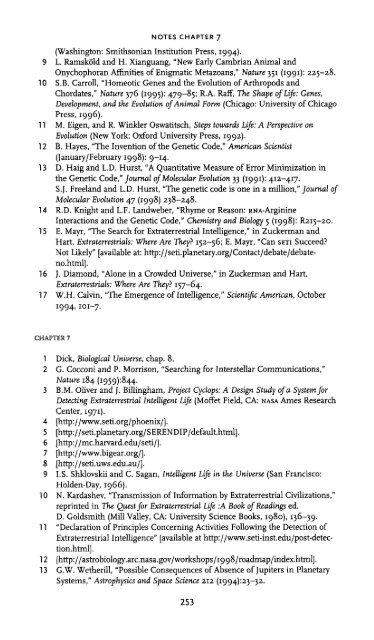You also want an ePaper? Increase the reach of your titles
YUMPU automatically turns print PDFs into web optimized ePapers that Google loves.
THE PLANET FINDERS<br />
seconds, which means that it should be able to detect a nearby star's<br />
wobble caused by the presence of a Jupiter-like planet.<br />
PTI can also operate in a simpler mode, in which it simply looks at a<br />
single star through the two telescopes. This technique cannot detect a<br />
star's wobble, but it can determine whether a star's image is a "point<br />
source" or is something more complicated, such as a binary pair. In<br />
1997, Mike Shao's group used this method on 51 Peg, the star whose<br />
now almost sacred "planet" was detected by Queloz and Mayor. Shao's<br />
group claimed to find that 51 Peg was a binary system, meaning that<br />
the "planet" was not a planet at all but a small companion star. They<br />
wrote an abstract on this finding that got onto the Internet and then<br />
into the pages of Science. But follow-up work showed that this result<br />
was incorrect: 51 Peg is indeed a single star, and the planet exists after<br />
all. When, on another occasion, we have the chance to ask Shao about<br />
this, he laughs and says "The final word is, one of our team members<br />
was a little bit overly enthusiastic. Once we got rid of two large sources<br />
of error, the wiggles weren't there." Since Queloz is now a member of<br />
Shao's team, the retraction has presumably smoothed the atmosphere<br />
within his lab.<br />
PTI'S main function, however, is not to detect or refute planets but<br />
to serve as a prototype for a succession of bigger and better interferometers.<br />
First, the Keck telescopes will be set up in differential interferometric<br />
mode: this will involve not just the integration of the two<br />
existing lo-meter telescopes but the construction of four small "outrigger"<br />
telescopes that will all be optically connected. 14 The Keck<br />
Interferometer is expected to have a precision of 10 to 30 microarcseconds<br />
and to be capable of detecting the wobble caused by Uranus-like<br />
planets orbiting stars as distant as 20 light-years from Earth.<br />
The Keck telescopes will also be capable of operation in another<br />
mode of interferometry, which should permit direct detection of the<br />
close-in Jupiters. In this mode, two starbeams from the star of interest<br />
are combined, and the fringe pattern measured. The measurement is<br />
done first at visible wavelengths—a region of the spectrum in which<br />
the star so greatly outshines the planet that the latter makes essentially<br />
no contribution to the fringe pattern. Then the measurement is repeated<br />
at infrared wavelengths—a region in which the planet, because<br />
it is heated by the nearby star, does make a small but detectable contribution.<br />
<strong>Be</strong>cause the planet is at a slight distance from the star, its<br />
contribution is out of phase, and it therefore shifts the overall fringe<br />
pattern slightly. By measuring this phase shift at many different ori-<br />
127













